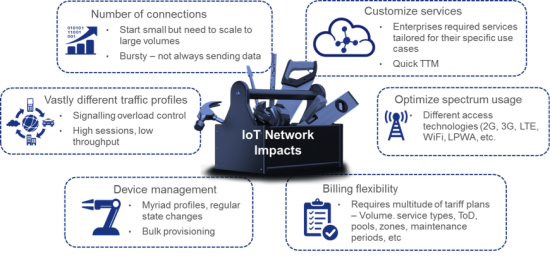The Internet of Things (IoT) is widely accepted as a key business opportunity for Mobile Service Providers (MSP) in the next 5 years. One recent report from Analysys Mason, predicts $8 billion in new IoT/M2M revenues from 2013 to 2019 in APAC alone. Other report predict even larger business potential, but where everyone agrees is that new IoT revenue is essential to compensate for other declining areas of revenue such-as voice and messaging.

Telecoms Revenue Growth by Service Type, Asia-Pacific, 2013-2019. Analysys Mason.
So shouldn’t MSPs just open the network doors to the tsunami of IoT devices and watch the money roll in? While leveraging existing network assets makes sense, there are important things to consider. Firstly, could the quality of existing services be impacted? IoT is about mass connectivity that could “flood” the access of current users leading in affect to a denial of service (DoS). Secondly we need to ensure that these devices can be connected in a profitable way, in that the cost to serve allows room for a margin. The predictions on number of devices and possible revenue per device varies (see below for one view), but we can expect the average income from connecting an IoT device will be a factor of 10 to 20 times lower then say a Smartphone. Maybe IoT margins can be lower if volumes are high, but we probably need to be aiming for at least a 10x lower cost to serve.

Analysis of Service Forecasts. Cisco VNI, GSMA, Machina
Other considerations include providing for IoT devices on very low power consumption, roaming partnerships, security, and identity and billing management.

IoT Network Challenges, Cisco
As a result today’s mobile networks need to evolve, to be more agile, cost efficient, and ready to support new classes of devices. So what are the technology enablers required to make them IoT optimised?

IoT Technology Enablers, Cisco
To make networks more agile and resilient to IoT demand, NFV, SDN and the Cloud are prime enablers. Not only will this make networks more elastic to demand, but also allows IoT traffic to be segmented when required.
Cloud based IoT platforms for device management, policy and billing are readily available. These can built in-house, or provided as a hosted service.
For Access the requirement for lower cost to serve, different mobility needs and new low power drain methods, means a mix of air interfaces is required. In licenced spectrum GSM, WCDMA and LTE play a role, plus new 5G methods in the future. In un-licensed spectrum short range (Zigbee, 802.11xx, etc.) and low power wide area (LPWA) technologies come in the mix. Tying this together is the proverbial HetNet; the common site HW, backhaul and SW to orchestrate everything most efficiently.
So the opportunity Mobile IoT is real and significant, but IoT service is fundamentally different from traditional Mobile Broadband service for which existing networks will have challenges to adapt to. The good news is there are some timely technologies like, NFV/SDN, Cloud and HetNet, which can all be leveraged to make IoT optimised networks of the future.

CONNECT WITH US